Making Needle Procedures More Comfortable for Children
The Comfort Promise from Children's Mercy
Kids tell us that one of the things they worry about when coming to Children’s Mercy is getting a shot or poke. Health care procedures, especially when they involve a needle, can be scary for children and teens.
When we give children ways to cope during needle procedures, it can help them:
- Have a sense of control,
- Be part of their own care,
- Cope with future health care events, and
- Have a better overall experience.
We understand. Needles hurt. We want to make it better.
At Children’s Mercy, we have a plan called the Comfort Promise that will help make your child’s needle procedure easier. A needle procedure could include a blood draw, a shot or placing an IV.
This is our Comfort Promise to you and your child:
- We will offer a special medicine to numb your child’s skin before the needle procedure.
- We will let your child sit up in a comfortable position with you supporting them.
- We will help your child think about fun things during the needle procedure. We can use things like a book, a game or a video.
- We will offer sugar water on a pacifier to babies or offer for moms to breastfeed during the needle procedure.
We promise to do everything we can to eliminate pain – one poke at a time.
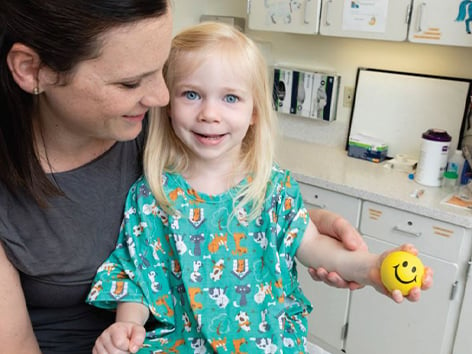
Overview of our Comfort Promise
We have put together a general overview of our Comfort Promise for needle procedures that you can download and print.
4% Lidocaine Cream
Learn how to apply topical lidocaine cream:
Age-specific guidance for comfort during needle procedures
The Comfort Promise is a layered approach to preventing pain with needle procedures. While the elements are all the same, the way they look is different at different ages. Location and type of procedure matter, too. Your care team will work with you to develop a plan appropriate to your child’s age, medical history, needle procedure type and Children’s Mercy location.
Above all, there is room for your child’s preferences and personality. Take a look at the suggestions for your child’s age group below and see how the Comfort Promise would work for your child.
- Numbing the skin: We have special medications we can put on your child’s skin to help them not feel the needle poke as much. Your care team will recommend which medication to use based on your child’s procedure, age, weight and the location on the body where it will take place.
- Cream
Read page 2 of our Comfort for Needle Procedures for instructions on using numbing cream.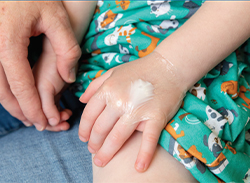
Lidocaine numbing cream applied to a child's hand. - J-Tip
See an example of the J-Tip in action (video).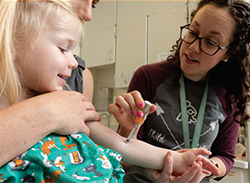
A J-Tip being used to apply numbing medication on a child's arm.
- Cream
- Comfort Positioning: Swaddling and holding babies provides them with comfort. We would like you or another caregiver (such as a nurse or Child Life specialist) to hold your child in a secure and comforting position during the procedure. This provides an opportunity for you as the parent to comfort them while also helping them to remain still and safe during their procedure. See our Coping Plan Cards on the Building Your Own Comfort Kit page for ideas on comforting holds for your child.
- Distraction: Distract your infant by helping them focus on something else. Common choices include books, music, rattles and toys that make noise. Singing, cooing, making eye contact and talking to your infant are also effective and do not require supplies. See below information on creating your own comfort kit for suggestions on what to bring with you.
If you need distraction items during your clinic or lab visit, you can go to the Kreamer Resource Center for Families ahead of your visit and check out a distraction kit. All inpatient areas and most outpatient areas also have distraction items you can use but availability varies. Child life specialists are also available to provide information, distraction and support. Please ask your nurse or other staff member to contact Child Life to help support you and your child during needle procedures or other health care events. - Sucrose/breastfeeding: We have sucrose (sugar water) that acts as a pain reliever for babies who are 18 months or younger. Sucrose should be given 2 minutes before the procedure and can be given on a pacifier, in a syringe or on a finger. We also encourage you to breastfeed during the needle stick because research shows it helps your baby feel less pain. Breastfeeding needs to begin 2-5 minutes before a procedure and continue during the procedure.
- Numbing the skin: We have special medications we can put on your child’s skin to help them not feel the needle poke as much. Your care team will recommend which medication to use based on your child’s procedure, age, weight and the location on the body where it will take place.
- Cream
Read page 2 of our Comfort for Needle Procedures for instructions on using numbing cream.
Lidocaine numbing cream applied to a child's hand. - J-Tip
See an example of the J-Tip in action (video).
A J-Tip being used to apply numbing medication on a child's arm.
- Cream
- Comfort Positioning: We know letting kids sit upright helps provide them with comfort and a sense of control. We would like you or another caregiver (such as a nurse or Child Life specialist) to hold your child in your lap in a secure and comforting position during the procedure. This provides an opportunity for you as the parent to comfort them while also helping them to remain still and safe during their procedure. See examples of comfort positioning in action (video).
- Distraction: Distract your child by helping them focus on something fun. Common choices include sound and pop up books, music, rattles, light up toys and other small, hand held toys that make noise. Playing counting games or games such as I Spy or singing are also fun and do not require supplies.
Taking deep breaths can also help the body relax and may make the procedure seem easier. With young children, this can be done by blowing bubbles, blowing on a pinwheel or pretending to breathe in the scent of flowers and then blow out the birthday candles.
It can be helpful to practice this skill ahead of time if you plan to use it during the procedure. See below information on creating your own comfort kit for suggestions on what to bring with you.
If you need distraction items during your clinic or lab visit, you can go to the Kreamer Resource Center for Families ahead of your visit and check out a distraction kit. All inpatient areas and most outpatient areas also have distraction items you can use but availability varies. Child life specialists are also available to provide information, distraction and support. Please ask your nurse or other staff member to contact Child Life to help support you and your child during needle procedures or other health care events.
- Numbing the skin: We have special medications we can put on your child’s skin to help them not feel the needle poke as much. Your care team will recommend which medication to use based on your child’s procedure, age, weight and the location on the body where it will take place.
- Cream
Read page 2 of our Comfort for Needle Procedures for instructions on using numbing cream.
Lidocaine numbing cream applied to a child's hand. - J-Tip
See an example of the J-Tip in action (video).
A J-Tip being used to apply numbing medication on a child's arm.
- Cream
- Comfort Positioning: We know letting kids sit upright helps provide them with comfort and a sense of control. We would like you or another caregiver (such as a nurse or Child Life specialist) to hold your child in your lap in a secure and comforting position during the procedure. This provides an opportunity for you as the parent to comfort them while also helping them to remain still and safe during their procedure. See examples of comfort positioning in action (video).
- Distraction: Distract your child by helping them focus on something fun. Common choices include books, music, hand-held toys, phones and tablets that allow them to play a preferred game or watch a short video. Playing counting games or games such as I Spy, singing and telling jokes are also fun and do not require supplies.
Taking deep breaths can also help the body relax and may make the procedure seem easier. Older kids can be encouraged to do this by blowing bubbles, blowing on a pinwheel or pretending to breathe in the scent of flowers and then blow out the birthday candles. As kids get older, they can practice and use other strategies to help breathe slowly and deeply (e.g., outlining a box on paper with their finger as they breathe in to a count of 4 and out to a count of 4).
It can be helpful to practice this skill ahead of time if you plan to use it during the procedure. For older kids, it also may be helpful to discuss whether they want to know when the procedure is going to happen or remain as distracted as possible throughout the procedure. See below information on creating your own comfort kit for suggestions on what to bring with you.
If you need distraction items during your clinic or lab visit, you can go to the Kreamer Resource Center for Families ahead of your visit and check out a distraction kit. All inpatient areas and most outpatient areas also have distraction items you can use, but availability varies. Child life specialists are also available to provide information, distraction and support. Please ask your nurse or other staff member to contact Child Life to help support you and your child during needle procedures or other health care events.
- Numbing the skin: We have special medications we can put on your child’s skin to help them not feel the needle poke as much. Your care team will recommend which medication to use based on your child’s procedure, age, weight and the location on the body where it will take place.
- Cream
Read page 2 of our Comfort for Needle Procedures for instructions on using numbing cream.
Lidocaine numbing cream applied to a child's hand. - J-Tip
See an example of the J-Tip in action (video).
A J-Tip being used to apply numbing medication on a child's arm.
- Cream
- Comfort Positioning: We know letting kids sit upright helps provide them with comfort and a sense of control. We would like you or another caregiver (such as a nurse or Child Life specialist) to hold or be next to your child during the procedure. For teens and tweens, it is important to get their input on what position feels best to them and what role they would like parents to play.
- Distraction: Distract your child by helping them focus on something fun. Common choices include music, phones, listening to a favorite playlist, using a hand-held game or watching a video. Talking with your child about special upcoming events (keep it positive!), telling jokes to one another or playing word games also can be fun and do not require supplies.
Taking deep breaths can also help the body relax and may make the procedure seem easier. Teens and tweens can be encouraged to do this by breathing in to a count of 4 and out to a count of 6. There are a variety of inexpensive or free apps that teens and tweens can use to pace their breathing during procedures (such as Breathe2Relax in the App Store or EZ-Air Plus) or that can help relax and distract them (such as the Calm app or relaxation videos on YouTube).
It can be helpful to practice this skill ahead of time if you plan to use it during the procedure. For teens and tweens, it also may be helpful to discuss whether they want to know when the procedure is going to happen or remain as distracted as possible throughout the procedure. See below information on creating your own comfort kit for suggestions on what to bring with you.
If you need distraction items during your clinic or lab visit, you can go to the Kreamer Resource Center for Families ahead of your visit and check out a distraction kit. All inpatient areas and most outpatient areas also have distraction items you can use, but availability varies. Child life specialists are also available to provide information, distraction and support. Please ask your nurse or other staff member to contact Child Life to help support you and your child during needle procedures or other health care events.
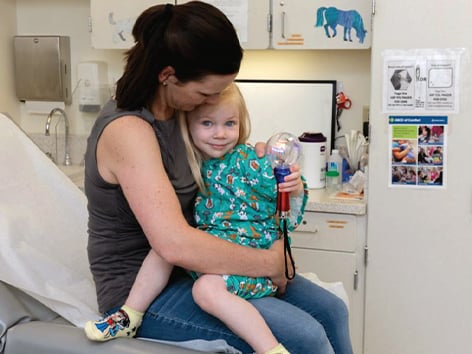
Build a comfort kit
You can help your child prepare for a needle procedure by building a comfort kit before their medical visit.
Create a needle procedure plan
If your child’s needs are more complex (e.g., he or she has a needle phobia, sensory issues), talk to your provider or contact Child Life about completing a My Needle Procedure Plan.
Our care teams are committed to making your child's experience as comfortable as possible, including our child life specialists.
Comfort Promise: Anna's story
Anna Beach had such severe needle phobia, it interfered with receiving vaccinations and having important lab tests done. Now thanks to Children’s Mercy’s Comfort Promise, an initiative to help kids cope with needle procedures, Anna is no longer afraid!

Comfort Promise: Mercy's story
Mercy White had a lot of anxiety surrounding needle procedures, and negative experiences reinforced past trauma. With the Comfort Promise, Mercy now has a plan in place that helps make sure these procedures go smoothly.

Additional resources
You may find these other resources helpful for you and your child when it comes to our Comfort Promise:
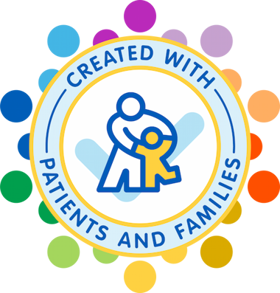
Patient and Family Seal of Collaboration
This material was developed in partnership with patients, families and Children's Mercy team members to improve the experience of healthcare and has earned the Patient and Family Seal of Collaboration. Learn more about the program and share your ideas with us.


